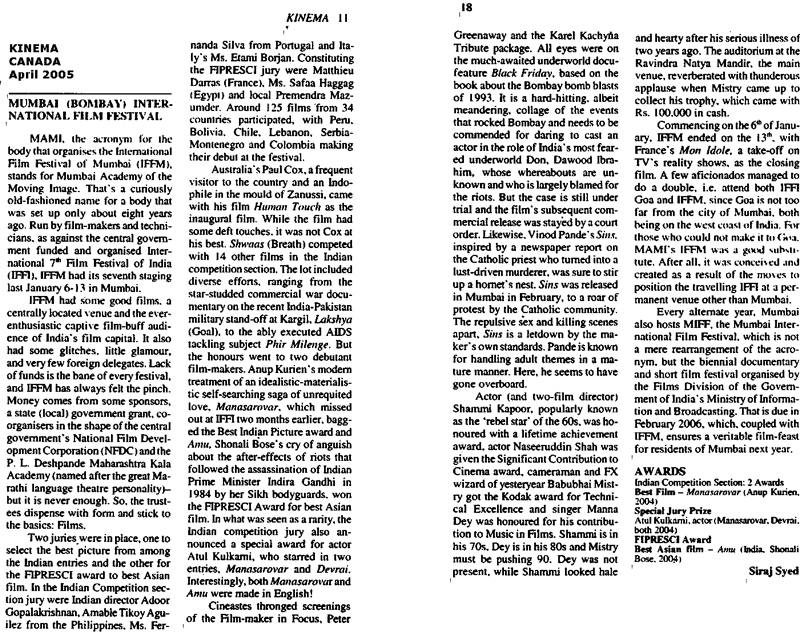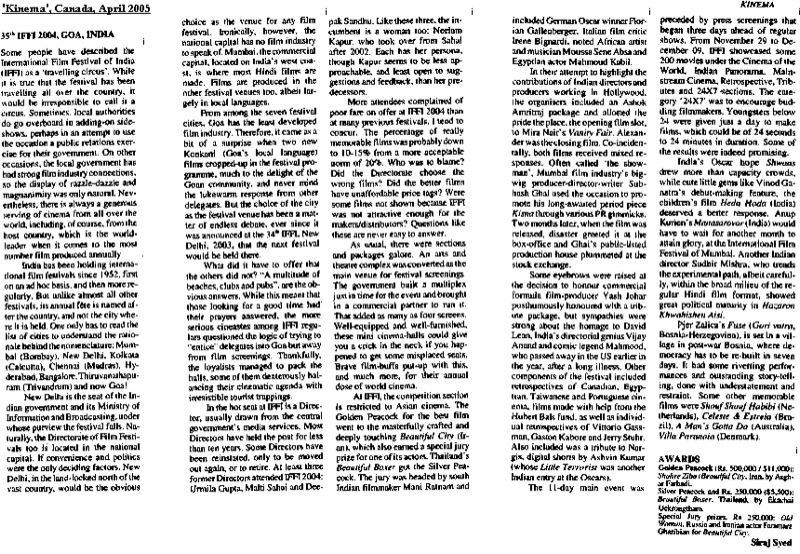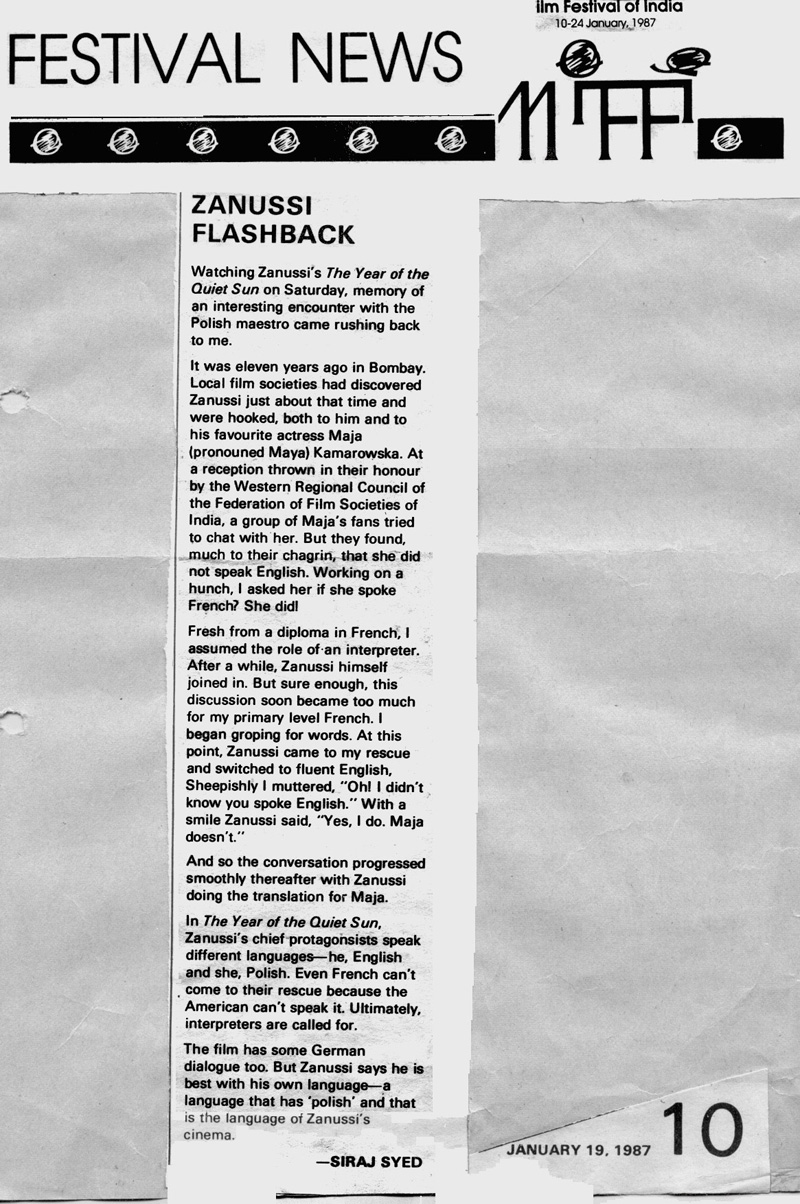|
|
||
|
Pro Tools
FILMFESTIVALS | 24/7 world wide coverageWelcome ! Enjoy the best of both worlds: Film & Festival News, exploring the best of the film festivals community. Launched in 1995, relentlessly connecting films to festivals, documenting and promoting festivals worldwide. Working on an upgrade soon. For collaboration, editorial contributions, or publicity, please send us an email here. User login |
Bharateeyans-The New Blood, Review: Overboard, gored, bored
Bharateeyans-The New Blood, Review: Overboard, gored, bored Preminchukundam Raa, Premante Idera, Kalisundam Raa, Eeswar (2002 film), Lahiri Lahirilo, Sardukupodaam Randi, Nagaram Nidrapotunna Vela and Sakhiya. These are not the names of the characters or cast of Bharateeyans-The New Blood, but the names of films written by Deena Raj, collaborating with Dr. Shankar Naidu Adsumilli, a well-known surgeon based in the USA. Deena Raj teams with Naidu again for his directorial debut, at age 53, Bharateeyans-The New Blood, produced by Shankar Naidu Adusumilli, under his Bharat American Creations. One does not know about the merits or fate of the earlier films, but Bharateeyans is very difficult to sit through. When patriotism is milked to the last drop, and the director has a free hand to stuff in as much as blood and gore as possible, you try and shift your gaze towards the heavenly scenery, instead of the ‘human’ drama that is unfolding on the Indo-China border. It’s not easy, so lucky are those who don’t get swayed by the title, and don’t head for the nearest cinema-hall where this gut-wrenching ultra nationalist saga is playing. Six strangers, three men, three women, meet at an unknown place in North-East India. They don't know each other. Each one of them has been told to reach there. There is a cloth orange band that is tied to one of their arms, as identification, and they have to wait for a pick-up that will come and take them to their pre-decided destination. What will happen once they get there, they do not know. Each one has a past, a past that includes a heinous crime, and the stranger they had met, who tied the band, has promised to help them escape punishment. A mini-bus arrives presently, and they are told to board it. Coming from different parts of the country, they start their journey without knowing what dangers are waiting for them. Comprising the six, all nameless, are a Telugu speaking man (his mother is from Bellary, in Karnataka), a Punjabi woman from Chandigarh, a Bhojpuri-speaking man, a Bengali woman, a Tripurarian dumb woman and a Nepali man. All have hopes and aspirations, and all have relatives that need to be looked after. But they agree to this proposal because the alternative is jail. When they arrive at the destination, they are put under commando/guerilla training, and in the process, they get to know each other. After a few days, their commander tells them that they have to go to China on a mission, crossing the border surreptitiously, with the help of a seasoned smuggler, an old man who walks with the help of a walking stick. In spite of very little training, they have to leave on the mission when told. Initially, they are very reluctant, but the thought of the welfare of their families prevails. Meanwhile, in the jungle, two lady Research and Analysis Wing (RAW), operatives, from India, are taking pictures of Chinese positions and forces. Four galloping lions form the video motif of the banner, and the makers thank Vivek Agnihotri, the director of film The Kashmir Files, a cult film on a similar theme. Agnihotri is to the post millennial generation what Manoj Kumar was to the filmgoers of the 60s, 70s and 80s. But the writing and direction occasionally peter down to the kind of cinema that I.S. Johar made, as a contemporary of Manoj Kumar. Whereas Manoj’s films had class and only very rarely went overboard, Johar made comedies under the garb of patriotism. Manoj lost it in the late 80s and 90s, and the films he made in this period do great disservice to his reputation. Johar, after making films on Goa and Kashmir, announced one called Johar and Johar in China. That one never saw the light of day. Bharateeyans, perhaps fuelled by high octane patriotism, often goes the Johar way. It trains it sights on China as the enemy, for a change, not Pakistan, but to its chagrin, finds all references to China deleted by the Central Board of Film Certification. But how can Pakistan not feature in an Indian film on terrorism? Every time China or Chinese is mentioned, all you hear is ‘ch’. But taking advantage of the fact that inhabitants of North-East India and Nepal, where there is a border with China, can pass off as Chinese, the makers have shot the film in Kalimpong, Gangtok, Rangpo, NHPC Dam, Chalsa, West Bengal, and the climax was shot at Sikkim. Quite obviously, the co-operation they received from the Indian armed forces stationed in those areas cannot be over-emphasised. Bharateeyans is another example of the crusade to change names from English to Hindi and from Muslim associated names to those that resonate clearly with the majority community. Bharateeyans is a stylised translation of Indian, derived from the official name of the country, which is Bharat. In an attempt, apparently, to blur the lines between Indians from various regions, they are all called by their region or language’s name. Besides the six above, there are characters from TamilNadu, Gujarat and Maharashtra. Sounds novel at first, but when a heroine calls her beau ‘Bhojpuri’ time and again, it is annoying. As the film progresses, you learn that the entire operation is a conspiracy, with a weird and convoluted genesis that gets more and more knotty, as the film progresses. All the scenes in the Minister’s office are shot in one session, probably in a few hours, and the result shows. Bharateeyans tests your suspension of disbelief, time and again, especially when masked assailants manage to attack, and then retreat, to true trunks in the matter of a second. The less said about the Maharashtrian angle the better. The woman gives a master class in how to bulge your eyes to the size of a lemon, without letting them pop out. Deena Raj shows a penchant for one second flash shots and putting the camera under a fleet of vehicles and capture them speeding out. It is not explained why all these diverse characters have assembled in the North-East, at the Indo-China Border, and how come the Maharashtrian woman has a posse of some 50 individuals following her in vehicles and on foot, as she yells and shrieks that she will wreak vengeance. On the Chinese side, a father and son are the Supremo and heir apparent, hardly imaginable in a sensitive zone, but neither wears a uniform. And many of the fights continue ad nauseam, with the Indian recruits having a go at the Chinese, and very rarely does the Chinese side use guns, and the fights are often one-to-one, hardly what a military division or battalion would indulge in. All hell is let loose in the second half, with victims being sliced by swords, dragged and buried, and, in one case, a hand being chopped off. Of the seven, two turn out to be not what they looked, one of which is a clever twist, while the other is a tribute to Johar.
Nirroze Putcha as Telugu is as rough as the character demands, and is inspired by Telugu films. Subha Ranjan Mukherjee as Bhojpuri is badly let down by the dubbing. Sonam Thendup Barphungpa as Nepali is a scene stealer, in a poorly written role. Showing guts and gumption is Samaira Sandhu as Punjabi, Peden O. Namgyal as Tripura has a lot of potential, and her dialogue is mainly in English, which might not have posed problems for the dubbing artiste. Rajeswari Chakraborty as Bengali, the cricketer from Kolkata, also gets into the act when she hears her calling. Also in the cast are Phurba Lama, Mahendra Bagdas, Sujata and Anupam. The actors playing the father and son have made an effort to make caricatures look real. The father reminds me of Rajnala in Farz. Satya Kashyap has done a good job with the music, with three songs. Cinematography by Jayapal Reddy Nimmala shows us many of the things a camera can do, especially in such picture-postcard locations. Overall, the dubbing is atrocious. Except for 2-3 shots right at the end, where the patriotic fervor of the audience spilled over and they applauded, there were hardly any moments where the film gripped you. It revels in going overboard, offering a generous dose of blood-letting and gore, which, in turn, leads to the audience getting bored. Bharateeyans has tons of patriotism, in all shapes and sizes, and if that is all that you need to make a booking, do go ahead. On the other hand, if you happen to be a sensitive, discerning cineaste, who wants his big-screen patriotism to meet certain standards, stay where you are. Rating: * ½ Trailer: https://youtu.be/vtgm9VqW6O8 12.07.2023 | Siraj Syed's blog Cat. : Anupam Bellary Bengali bhojpuri Chalsa Chandigarh Deena Raj Eeswar Gangtok I.S. Johar Indo-China border Kalimpong Kalisundam Raa Karnataka Kolkata Lahiri Lahirilo Mahendra Bagdas Manoj Kumar Nagaram Nidrapotunna Vela Nepali NHPC Dam Nirroze Putcha Peden O. Namgyal Phurba Lama Premante Idera Preminchukundam Raa Punjabi Rajeswari Chakraborty Rangpo Research and Analysis Wing Sakhiya Samaira Sandhu Sardukupodaam Randi Shankar Naidu Adsumilli Sikkim Sonam Thendup Barphunga Sonam Thendup Barphungpa Subha Ranjan Mukherjee Sujata telugu Tripura Tripurarian West Bengal
|
LinksThe Bulletin Board > The Bulletin Board Blog Following News Interview with EFM (Berlin) Director
Interview with IFTA Chairman (AFM)
Interview with Cannes Marche du Film Director
Filmfestivals.com dailies live coverage from > Live from India
Useful links for the indies: > Big files transfer
+ SUBSCRIBE to the weekly Newsletter Deals+ Special offers and discounts from filmfestivals.com Selected fun offers
> Bonus Casino
User imagesAbout Siraj Syed Syed Siraj Syed Siraj (Siraj Associates) Siraj Syed is a film-critic since 1970 and a Former President of the Freelance Film Journalists' Combine of India.He is the India Correspondent of FilmFestivals.com and a member of FIPRESCI, the international Federation of Film Critics, Munich, GermanySiraj Syed has contributed over 1,015 articles on cinema, international film festivals, conventions, exhibitions, etc., most recently, at IFFI (Goa), MIFF (Mumbai), MFF/MAMI (Mumbai) and CommunicAsia (Singapore). He often edits film festival daily bulletins.He is also an actor and a dubbing artiste. Further, he has been teaching media, acting and dubbing at over 30 institutes in India and Singapore, since 1984.View my profile Send me a message The EditorUser contributions |





























